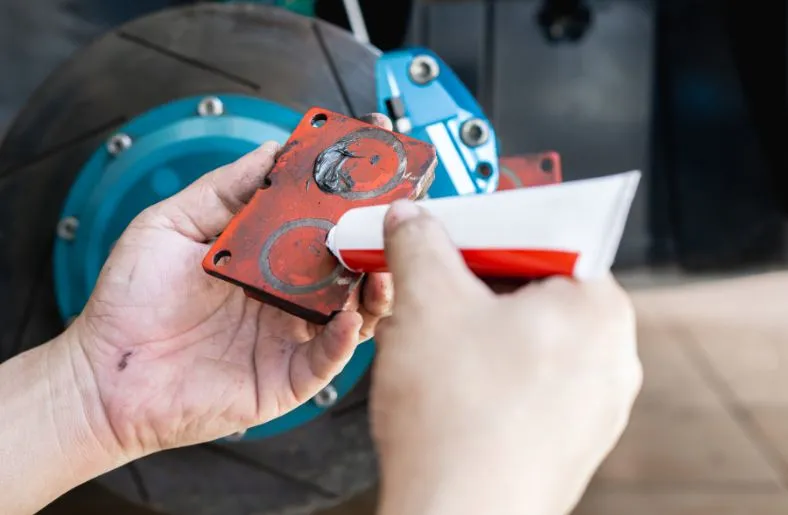When it comes to maintaining and preserving the longevity of mechanical components, anti-seize compounds play a crucial role. These compounds are specifically designed to prevent seizing, galling, and corrosion in metal-to-metal contact situations. By reducing friction and protecting against rust and oxidation, anti-seize compounds ensure that threaded fasteners, fittings, and other mechanical parts can be easily disassembled even after extended periods of use.
In this blog, we shall explore the key differences between copper anti-seize vs silver anti-seize.
Table of Contents
What is Copper Anti-Seize?
Copper anti-seize is a lubricating compound containing copper particles suspended in a grease or oil base. The copper particles act as solid lubricants, providing a protective barrier between metal surfaces.
This compound is highly resistant to extreme temperatures and pressures, making it ideal for heavy-duty applications. Copper anti-seize is commonly used in automotive, marine, and manufacturing industries.
Shop my favourite items below:
- Permatex 09128 Copper Anti-Seize Lubricant: https://amzn.to/4grqqop
- Permatex 80208 Anti-Seize Lubricant With Brush Top Bottle Prevents Galling, Corrosion, Seizing, Refined Blend Aluminum, Copper, And Graphite Lubricants For Spark Plugs: https://amzn.to/4hyVZOf
- Permatex 77134 Nickel Anti-Seize Lubricant: https://amzn.to/4aFiOxo
What is Silver Anti-Seize?
Silver anti-seize, on the other hand, is a lubricating compound that contains silver particles suspended in a grease or oil base. Similar to copper anti-seize, silver anti-seize provides excellent lubrication and corrosion protection.
However, silver anti-seize offers some unique properties that make it suitable for certain applications. It has a higher thermal conductivity and better electrical conductivity compared to copper anti-seize. This makes it particularly useful in electrical and electronic applications where conductivity is important.
Composition and Properties of Copper Anti-Seize vs Silver Anti-Seize
Copper anti-seize is typically composed of copper particles, graphite, and other additives. The copper particles provide excellent lubrication and corrosion protection, while the graphite enhances the lubricating properties by reducing friction.
Other additives may include anti-oxidants and anti-wear agents to further improve the performance of the compound. Copper anti-seize has a high-temperature resistance, allowing it to withstand extreme heat without losing its lubricating properties.
Silver anti-seize is composed of silver particles, graphite, and other additives. The silver particles provide superior lubrication and corrosion protection, while the graphite helps reduce friction. The presence of silver in the compound also enhances its electrical and thermal conductivity.
This makes silver anti-seize an excellent choice for applications where electrical conductivity is critical, such as in the assembly of electrical connectors and switches. Additionally, silver anti-seize maintains its lubricating properties even at high temperatures.
Key Differences between Copper Anti-Seize vs Silver Anti-Seize
While both copper and silver anti-seize compounds serve the same purpose of preventing seizing and corrosion, they differ in their composition and properties. Copper anti-seize is known for its high-temperature resistance and is commonly used in heavy-duty applications. It provides excellent lubrication and corrosion protection but has slightly lower electrical and thermal conductivity compared to silver anti-seize.
On the other hand, silver anti-seize offers superior electrical and thermal conductivity, making it suitable for electronic and electrical applications. It still provides excellent lubrication and corrosion protection but may not be as resistant to high temperatures as copper anti-seize. The choice between copper and silver anti-seize ultimately depends on the specific requirements of the application.
Applications and Uses of Copper Anti-Seize vs Silver Anti-Seize
Copper anti-seize finds widespread use in various industries. It is commonly used in automotive applications, such as on spark plugs, exhaust systems, and brake components. The high-temperature resistance of copper anti-seize makes it ideal for use in engine components that are subjected to extreme heat.
It is also used in marine applications, where it protects against the corrosive effects of saltwater and provides lubrication in marine engines and fittings. In the manufacturing industry, copper anti-seize is utilized in machinery and equipment assembly to prevent seizing and facilitate smooth disassembly.
Silver anti-seize is particularly well-suited for applications where electrical conductivity is crucial. It is commonly used in the assembly of electrical connectors, switches, and circuit breakers. The silver particles in the compound ensure a low electrical resistance, preventing voltage drop and improving the overall performance of electrical systems.
Silver anti-seize is also used in high-temperature applications where moderate lubrication and corrosion protection are required, such as in the assembly of industrial furnaces and kilns.
Related Guide: Is Dielectric Grease Necessary for Spark Plugs? (2024)
When to Use Copper Anti-Seize
Copper anti-seize is the preferred choice when it comes to high-temperature applications. Its ability to withstand extreme heat without losing its lubricating properties makes it suitable for use in engines, exhaust systems, and other components that operate at elevated temperatures.
Copper anti-seize is also recommended for applications exposed to corrosive environments, such as marine and offshore equipment.
When to Use Silver Anti-Seize
Silver anti-seize is best suited for applications where electrical conductivity is a primary concern. It is commonly used in the assembly of electrical components, where it ensures proper electrical connections and prevents voltage drop.
Silver anti-seize is also suitable for applications that require moderate lubrication and corrosion protection at high temperatures, making it a versatile choice for various industries.
Pros and Cons of Copper Anti-Seize vs Silver Anti-Seize
Copper anti-seize offers several advantages, such as high-temperature resistance, excellent lubrication, and corrosion protection. Its ability to withstand extreme heat makes it ideal for heavy-duty applications. However, copper anti-seize may not be suitable for electrical applications that require high conductivity.
On the downside, copper anti-seize can leave behind copper residue, which may cause staining or discoloration on certain surfaces. Additionally, copper anti-seize is not recommended for use in applications involving stainless steel, as it can promote galvanic corrosion.
Silver anti-seize offers superior electrical and thermal conductivity, making it ideal for electrical and electronic applications. It provides excellent lubrication and corrosion protection, albeit at slightly lower temperatures compared to copper anti-seize. Silver anti-seize also leaves no residue and is safe to use on a wide range of surfaces, including stainless steel.
However, silver anti-seize is generally more expensive than copper anti-seize. It may not be necessary for applications that do not require high electrical conductivity.
Which Anti-Seize Compound is Right for Your Application?
Choosing between copper and silver anti-seize depends on the specific requirements of your application. If you are dealing with high-temperature environments or corrosive conditions, copper anti-seize is the preferred choice.
On the other hand, if electrical conductivity is critical or if you need moderate lubrication and corrosion protection at high temperatures, silver anti-seize is the better option.
Conclusion
Copper anti-seize vs silver anti-seize compounds are effective in preventing seizing, galling, and corrosion. Copper anti-seize excels in high-temperature applications and offers excellent lubrication and corrosion protection. Silver anti-seize, on the other hand, provides superior electrical and thermal conductivity, making it suitable for electrical and electronic applications.
When selecting an anti-seize compound, consider the specific requirements of your application and choose the one that best meets your needs. Whether it’s copper or silver anti-seize, these compounds are essential in maintaining the efficiency and longevity of mechanical components. So, make the right choice and ensure smooth operations in your industry.

